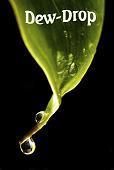PURE WATER EXTRACTED FROM PLANTS
There are a number of ways to extract water from plants and almost all water from plants is clean, pure and ready to drink. With the exception of toxic or high resin plants 98% of all plant material contains purified water.
There is a destructive and a non destructive method of gathering water from plants.
How to get drinking water from plants
The Non Destructive Method
The non destructive method typically involves tying a plastic bag over a leafy branch and allowing the plant to transpire into the bag. Another way to put this is to collect the plant respirated water vapor. Either way you say it, it is an effective way to get clean, pure water.
The downside is you need a lot of plastic bags to collect enough water to live on. Look at this method as a supplemental water supply.
1) Select an appropriate plant/s.
Water loving trees and plants such as willow, cottonwood and berry producing shrubs are the best choice. Of course there probably aren't any of those around where you are and when you need them, so the next best thing is anything with leaves. The larger leaves the better. Leaves with a large surface area tend to give off more moisture than smaller leafed trees and bushes. This is true about 85% of the time and is the safest bet to follow.
2) Enclose a live, leafy branch with a bag and tie off around the stem. Whenever possible use clear bags.
Any plastic bag will work, but clear bags will catch water and the sun will also help dehydrate the enclosed branch because of the increased heat.
3) Water will gather at the lowest point in the bag. Keep that in mind when it comes time to harvest your water.
4) Allow 4 - 5 hours for the water to collect in the plastic bag.
5) Harvest the water and drink up!
How to get drinking water from plants
The Destructive Method
One of the most common destructive ways to extract drinking water from a plant is to cut a stem or tap the trunk. You either allow the tapped liquid to flow into a container or suck the moisture out with your mouth.
Be careful about placing your mouth on twigs and branches as these outer part usually contain bacteria.
Drinking water from a Cactus
In the desert, one of the most common plants to provide you with water is the cacti or prickly pear cactus. You can simply cut a notch in the cactus to allow surplus liquid to drain. If the prickly pear is low on water you may be forced to chop off a branch and squeeze the fibers like a sponge to extract the liquid. This can be hard on your hands due to the prickles and it is definitely hard on the cacti. You will et some cacti type water from the fibers but the main cacti will continue to slowly "bleed" for some time after you remove the branch. This is something to consider BEFORE you remove cacti bits.
Of course, if you are dying of thirst and it is between you and the cactus, you are going to do a little surgery on the cactus to save your life.
Drinking water from a Banana Tree
Okay, I realize most of us don't have to worry about tripping on the banana tree out back, but, your knowledge base wouldn't be complete unless you learned about getting drinking water from a banana tree. (Pretend you are stuck on a tropical island).
1) After you have found a full size banana tree, chop it down leaving about 18" of stump sticking out of the ground. (I hope you were marooned with something to chop down the tree with).
2) Using a rock or knife, dish out the top of the stump forming a bowl as deep as possible with 8" being your target.
3) This bowl will fill full of liquid which is undrinkable. Empty the liquid and let the bowl fill again.
4) By about the 4th bowl of liquid, drink up! This will be clean, drinkable water.
5) You might want to cover the cut bowl in the stump with some banana leave to help keep the insects out.
Drinking water from a Coconut Tree
Of course you can drink the milk or water from the coconut, BUT, did you know that the liquid from mature coconuts are also a natural laxative? You can drink your fill of coconut "water" if you follow these simple steps.
1) Seek out only immature or green coconuts.
2) These juvenile coconuts are safe to drink from but should only be stored for a maximum of 4 days.
3) The best advice. Pick young coconuts only as you need them for drinking "water" (watery milk).
Using them in this way will keep you hydrated and healthy without excessive bathroom trips.
|



